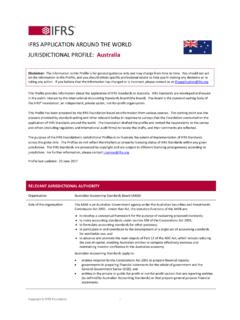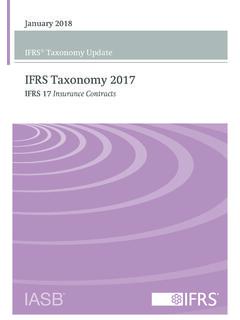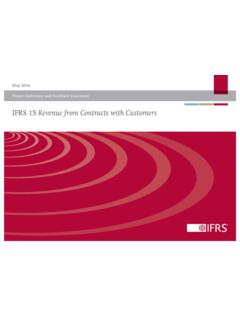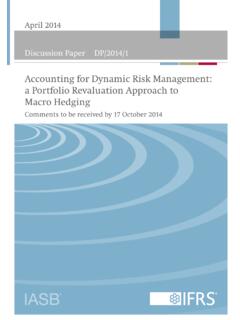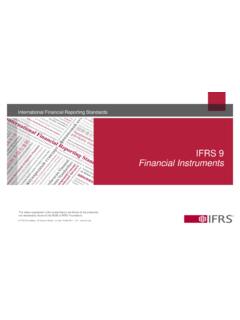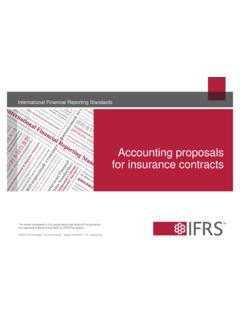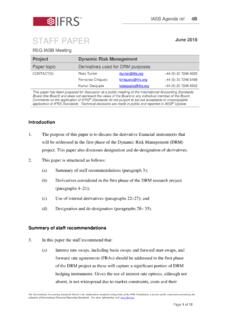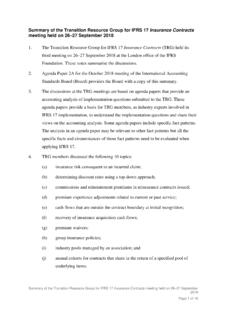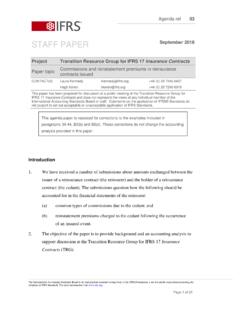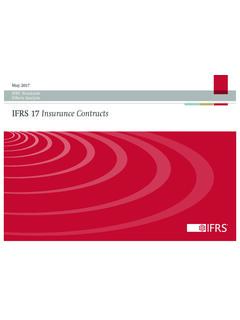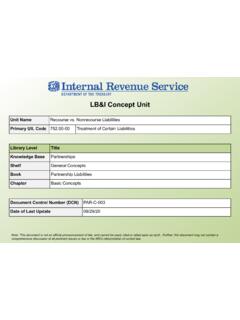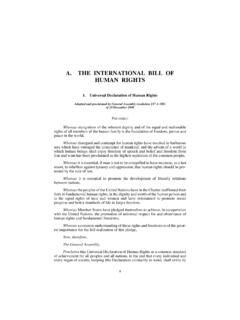Transcription of Statement of Cash Flows
1 IAS 7 Statement of Cash FlowsIn April 2001 the International Accounting Standards Board adopted IAS 7 Cash FlowStatements, which had originally been issued by the International Accounting StandardsCommittee in December 1992. IAS 7 Cash Flow Statements replaced IAS 7 Statement ofChanges in Financial Position (issued in October 1977).As a result of the changes in terminology used throughout the IFRS Standards arisingfrom requirements in IAS 1 Presentation of Financial Statements (issued in 2007), the title ofIAS 7 was changed to Statement of Cash January 2016 IAS 7 was amended by Disclosure Initiative (Amendments to IAS 7). Theseamendments require entities to provide disclosures about changes in liabilities arisingfrom financing Standards have made minor consequential amendments to IAS 7.
2 They includeIFRS 10 Consolidated Financial Statements (issued May 2011), IFRS 11 Joint Arrangements(issued May 2011), Investment Entities (Amendments to IFRS 10, IFRS 12 and IAS 27) (issuedOctober 2012), IFRS 16 Leases (issued January 2016) and IFRS 17 Insurance Contracts (issuedMay 2017).IAS 7 IFRS FoundationA1035 CONTENTS from paragraphINTERNATIONAL ACCOUNTING STANDARD 7 Statement OF CASH FLOWSOBJECTIVESCOPE1 BENEFITS OF CASH FLOW INFORMATION4 DEFINITIONS6 Cash and cash equivalents7 PRESENTATION OF A Statement OF CASH FLOWS10 Operating activities13 Investing activities16 Financing activities17 REPORTING CASH Flows FROM OPERATING ACTIVITIES18 REPORTING CASH Flows FROM INVESTING AND FINANCING ACTIVITIES21 REPORTING CASH Flows ON A NET BASIS22 FOREIGN CURRENCY CASH FLOWS25 INTEREST AND DIVIDENDS31 TAXES ON INCOME35 INVESTMENTS IN SUBSIDIARIES.
3 ASSOCIATES AND JOINT VENTURES37 CHANGES IN OWNERSHIP INTERESTS IN SUBSIDIARIES AND OTHERBUSINESSES39 NON-CASH TRANSACTIONS43 CHANGES IN LIABILITIES ARISING FROM FINANCING ACTIVITIES44 ACOMPONENTS OF CASH AND CASH EQUIVALENTS45 OTHER DISCLOSURES48 EFFECTIVE DATE53 APPROVAL BY THE BOARD OF DISCLOSURE INITIATIVE (AMENDMENTSTO IAS 7) ISSUED IN JANUARY 2016 FOR THE ACCOMPANYING GUIDANCE LISTED BELOW, SEE PART B OF THIS EDITIONILLUSTRATIVE EXAMPLESFOR THE BASIS FOR CONCLUSIONS, SEE PART C OF THIS EDITIONBASIS FOR CONCLUSIONSDISSENTING OPINIONIAS 7A1036 IFRS FoundationInternational Accounting Standard 7 Statement of Cash Flows (IAS 7) is set outin paragraphs 1 61. All the paragraphs have equal authority but retain the IASC format of the Standard when it was adopted by the IASB.
4 IAS 7 should be read in thecontext of its objective and the Basis for Conclusions, the Preface to IFRS Standards andthe Conceptual Framework for Financial Reporting. IAS 8 Accounting Policies, Changes inAccounting Estimates and Errors provides a basis for selecting and applying accountingpolicies in the absence of explicit 7 IFRS FoundationA1037 International Accounting Standard 7 Statement of Cash Flows1 ObjectiveInformation about the cash Flows of an entity is useful in providing users of financialstatements with a basis to assess the ability of the entity to generate cash and cashequivalents and the needs of the entity to utilise those cash Flows .
5 The economicdecisions that are taken by users require an evaluation of the ability of an entity togenerate cash and cash equivalents and the timing and certainty of their objective of this Standard is to require the provision of information about thehistorical changes in cash and cash equivalents of an entity by means of a Statement ofcash Flows which classifies cash Flows during the period from operating, investing andfinancing entity shall prepare a Statement of cash Flows in accordance with therequirements of this Standard and shall present it as an integral part of itsfinancial statements for each period for which financial statements Standard supersedes IAS 7 Statement of Changes in Financial Position,approved in July of an entity s financial statements are interested in how the entitygenerates and uses cash and cash equivalents.
6 This is the case regardless of thenature of the entity s activities and irrespective of whether cash can be viewedas the product of the entity, as may be the case with a financial need cash for essentially the same reasons however different theirprincipal revenue-producing activities might be. They need cash to conducttheir operations, to pay their obligations, and to provide returns to theirinvestors. Accordingly, this Standard requires all entities to present astatement of cash of cash flow informationA Statement of cash Flows , when used in conjunction with the rest of thefinancial statements, provides information that enables users to evaluate thechanges in net assets of an entity, its financial structure (including itsliquidity and solvency) and its ability to affect the amounts and timing of cashflows in order to adapt to changing circumstances and opportunities.
7 Cashflow information is useful in assessing the ability of the entity togenerate cash and cash equivalents and enables users to develop models toassess and compare the present value of the future cash Flows of differententities. It also enhances the comparability of the reporting of operating12341In September 2007 the IASB amended the title of IAS 7 from Cash Flow Statements to Statement ofCash Flows as a consequence of the revision of IAS 1 Presentation of Financial Statements in 7A1038 IFRS Foundationperformance by different entities because it eliminates the effects of usingdifferent accounting treatments for the same transactions and cash flow information is often used as an indicator of the amount,timing and certainty of future cash Flows .
8 It is also useful in checking theaccuracy of past assessments of future cash Flows and in examining therelationship between profitability and net cash flow and the impact ofchanging following terms are used in this Standard with the meanings specified:Cash comprises cash on hand and demand equivalents are short-term, highly liquid investments that are readilyconvertible to known amounts of cash and which are subject to aninsignificant risk of changes in Flows are inflows and outflows of cash and cash activities are the principal revenue-producing activities of theentity and other activities that are not investing or financing activities are the acquisition and disposal of long-term assets andother investments not included in cash activities are activities that result in changes in the size andcomposition of the contributed equity and borrowings of the and cash equivalentsCash equivalents are held for the purpose of meeting
9 Short-term cashcommitments rather than for investment or other purposes. For aninvestment to qualify as a cash equivalent it must be readily convertible to aknown amount of cash and be subject to an insignificant risk of changes invalue. Therefore, an investment normally qualifies as a cash equivalent onlywhen it has a short maturity of, say, three months or less from the date ofacquisition. Equity investments are excluded from cash equivalents unlessthey are, in substance, cash equivalents, for example in the case of preferredshares acquired within a short period of their maturity and with a specifiedredemption borrowings are generally considered to be financing activities.
10 However,in some countries, bank overdrafts which are repayable on demand form anintegral part of an entity's cash management. In these circumstances, bankoverdrafts are included as a component of cash and cash equivalents. Acharacteristic of such banking arrangements is that the bank balance oftenfluctuates from being positive to Flows exclude movements between items that constitute cash or cashequivalents because these components are part of the cash management of anentity rather than part of its operating, investing and financing management includes the investment of excess cash in cash 7 IFRS FoundationA1039 Presentation of a Statement of cash flowsThe Statement of cash Flows shall report cash Flows during the periodclassified by operating, investing and financing entity presents its cash Flows from operating.
